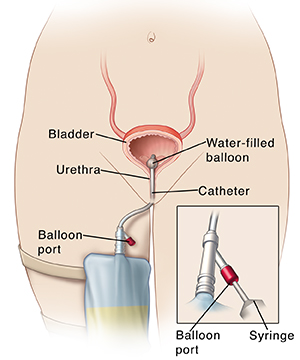Your health care provider has instructed you to remove your indwelling urinary catheter. It's also called a Foley catheter. This is a thin, flexible tube that allows urine to drain out of your bladder and into a bag. It’s important to correctly remove your catheter to help prevent infection and other complications. If you have any questions about removing the Foley catheter, ask your provider before trying to remove it. Otherwise, follow the instructions on this sheet.
Foley catheter
The Foley catheter is held in place by a small balloon that’s filled with water. To remove the catheter, you must first drain the water from the balloon. This is done using a syringe and the balloon port. This is the opening in the catheter that isn’t attached to the bag. It allows you to get to the balloon.
Instructions for removing the catheter
Follow the directions closely. If the catheter doesn’t come out with gentle pulling, stop and call your health care provider right away.
-
Empty the bag of urine if needed.
-
Wash your hands with soap and clean, running water. Dry them well.
-
Gather your supplies. This includes a wastebasket, a towel, and a syringe that was given to you by your provider.
-
Put the syringe into the balloon port on the catheter. The syringe fits tightly into the port with a firm push and twist motion.
-
Wait as the water from the balloon empties into the syringe. Depending on how large the balloon is, you may need to repeat this process several times until all of the water is out of the balloon.
-
Once the balloon is emptied, gently pull out the catheter.
-
Put the used catheter in the wastebasket. Also throw away the syringe.
-
Use the towel to wipe up any spilled water or urine if needed.
-
Wash your hands again.
When to call your doctor
Call your health care provider right away if:
-
You have a fever of
100.4 ° F (38 °C ) or higher, or as directed by your provider. -
You have questions about removing the catheter.
-
The catheter doesn’t come out with gentle pulling.
-
You can’t urinate within
8 hours after removing the catheter. -
Your belly (abdomen) is painful or bloated.
-
You have burning pain with urination that lasts for
24 hours. -
You see a lot of blood in the urine. Light bleeding for
24 hours is normal. -
It feels like the bladder is not emptying.


